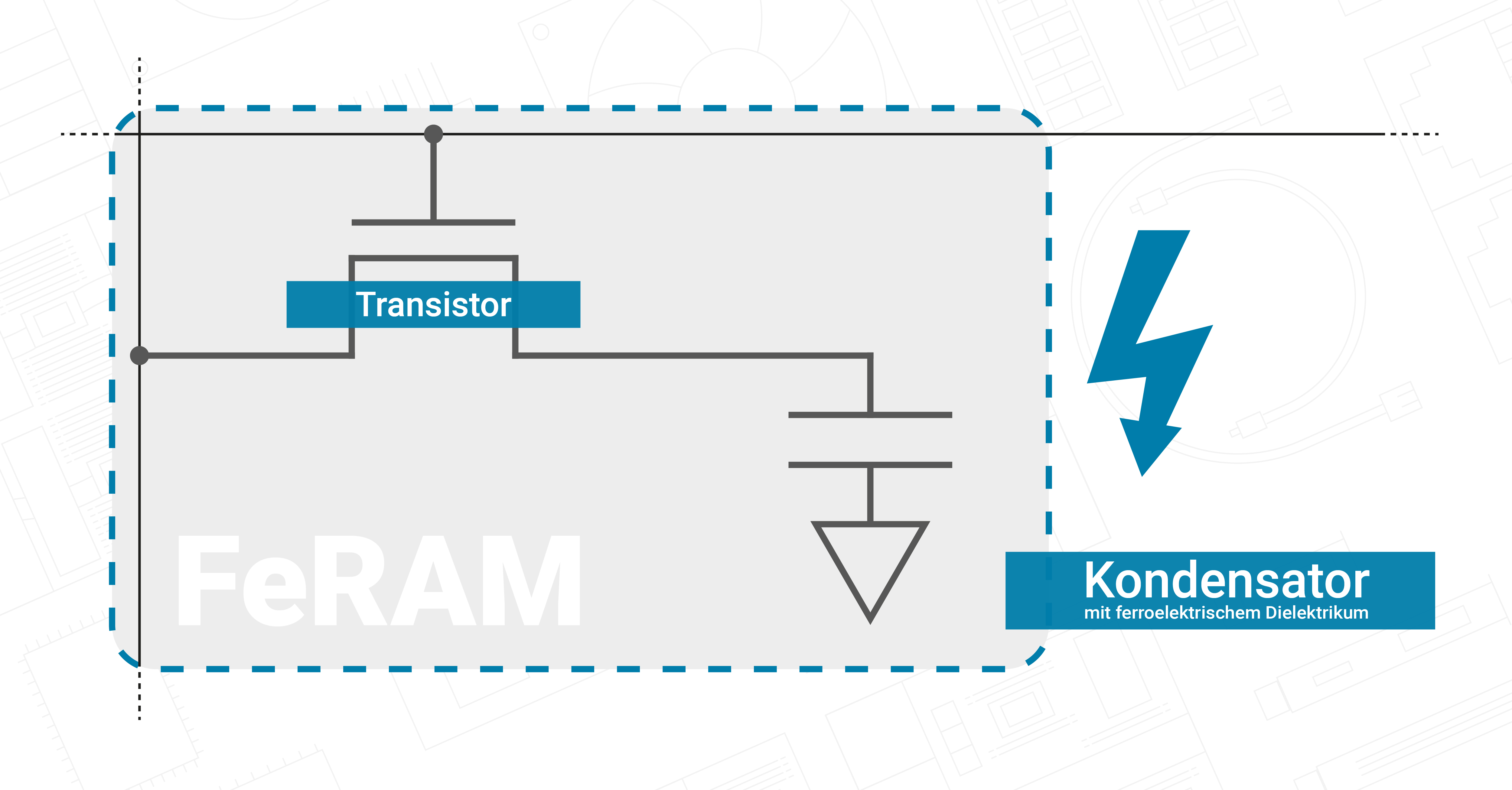
- 24 May 2023
- Back to overview
FeRAM: Innovative alternative to EEPROM
FeRAM (Ferroelectric RAM)
FeRAM (ferroelectric RAM) is a type of non-volatile RAM (random access memory). The FeRAM is characterized by a particularly high data retention, i.e.: even at 125°C, the data is retained for over 10 years if the power supply is interrupted.
It is named after the ferroelectric dielectric of the capacitor. We will briefly discuss this at the end of the article in the context of how this storage technology works. First, however, we will take a look at the most important properties and some areas of application for the technology.
Table of contents
FeRAM Properties
FeRAM (Ferroelectric RAM) is a non-volatile memory that retains stored data even without power—unlike DRAM, which requires constant refresh cycles. FeRAM combines the speed of RAM with the persistence of Flash or EEPROM. It is pin-compatible with common EEPROMs, but offers significantly faster write performance, lower power consumption, and much higher write endurance.
Below, we summarize the key characteristics of FeRAM. Due to its comparatively higher cost, FeRAM is typically chosen only when at least one of these properties is essential for the application.
FeRAM consumes significantly less energy when writing and erasing data than other non-volatile memories like EEPROM or Flash. One reason is that FeRAM allows individual bits to be written directly—without the need to erase an entire memory block beforehand. Other technologies usually work block-wise and require energy-intensive charge pumps to perform write operations.
FeRAM operates at low voltages (typically 1.5–3.3 V) and can write data in just a few nanoseconds. This makes it ideal for power-sensitive applications, such as battery-operated devices or systems based on energy harvesting.
FeRAM supports extremely high write/erase cycles—up to 1014 per cell, according to some manufacturers. In contrast, EEPROM and Flash typically allow between 104 and 106 cycles. This makes FeRAM exceptionally durable and well suited for applications requiring frequent data writes, such as smart meters or industrial control systems with continuous data logging.
FeRAM is immune to magnetic fields and X-rays. Although the term “ferroelectric” may sound magnetic, FeRAM uses no magnetic materials. As a result, data is not affected by electromagnetic interference. In medical applications, this property is especially valuable—for example, in devices exposed to diagnostic environments or electromagnetic fields.
FeRAM memory cells are based on ferroelectric materials such as PZT (lead zirconate titanate), which can be electrically polarized in two stable states. These states represent logical “0” and “1” and persist even after power is removed. This enables fast, low-power, and non-volatile data storage. More on this can be found in the “How FeRAM Works” section.
FeRAM Applications
Please note: whether FeRAM is the right choice for a specific application depends on many design-specific factors. The following examples aim to provide context for FeRAM’s capabilities—not product recommendations.
FeRAM’s unique combination of power efficiency, write endurance, and robustness makes it suitable for various industrial and safety-critical applications. Here are some common use cases:
FeRAM is well suited for use in industrial control systems such as programmable logic controllers (PLCs). It reliably stores critical states, counters, or fault logs—even in the event of a sudden power loss. Its long write endurance eliminates the need for battery-backed RAM or frequent maintenance.
Smart meters and similar measurement systems benefit from FeRAM because they store small data sets frequently while operating on minimal power. With its fast write speed and long endurance, FeRAM supports reliable, long-term data logging—especially in devices that must function maintenance-free for years.
FeRAM is often chosen for systems that must retain the last known state during unexpected shutdowns—such as airbag modules in vehicles or flight recorders (“black boxes”) in aircraft. Its non-volatility and ultra-fast write performance ensure that no data is lost, even in the event of an immediate power failure.
Medical devices like insulin pumps or pacemakers use FeRAM to store critical patient data and configuration parameters. Its immunity to X-rays and ability to function in harsh environments make it highly reliable. Devices based on energy harvesting also benefit from FeRAM's low power requirements, as it allows storage with minimal available energy.
How FeRAM Works
Like DRAM, FeRAM cells consist of a transistor and a capacitor. However, the capacitor in FeRAM is built using a ferroelectric dielectric material (e.g., PZT), which allows it to store information via polarization—without suffering from leakage currents like conventional DRAM.
How is information stored in FeRAM?When an electric field is applied, the polarization state of the ferroelectric material switches to represent a binary “0” or “1.” This state persists even after the power is removed. Reading the stored data involves briefly switching the polarization, which destroys the current value—hence FeRAM includes an automatic write-back (“destructive read”). Despite this, the process is extremely fast and highly energy-efficient.

Sources
-
 High-Performance Computing Infrastructure to Support Molecular ResearchMaximilian Jaud | 10 February 2025The system configuration enables highly complex computations to run in parallel while efficiently processing large datasets.Mehr lesen
High-Performance Computing Infrastructure to Support Molecular ResearchMaximilian Jaud | 10 February 2025The system configuration enables highly complex computations to run in parallel while efficiently processing large datasets.Mehr lesen -
 High-Performance Virtualization Platform based on ProxmoxMaximilian Jaud | 31 January 2025Redundant high-performance platform capable of virtualizing around 200 servers for diverse applications, featuring fast NVMe storage for active workloads and large HDD storage for long-term archiving.Mehr lesen
High-Performance Virtualization Platform based on ProxmoxMaximilian Jaud | 31 January 2025Redundant high-performance platform capable of virtualizing around 200 servers for diverse applications, featuring fast NVMe storage for active workloads and large HDD storage for long-term archiving.Mehr lesen -
 High-Performance and Fail-Safe System for CybersecurityMaximilian Jaud | 16 December 2024To support complex security processes, the customer required a high-performance, scalable IT infrastructure.Mehr lesen
High-Performance and Fail-Safe System for CybersecurityMaximilian Jaud | 16 December 2024To support complex security processes, the customer required a high-performance, scalable IT infrastructure.Mehr lesen -
 High-Performance IT Infrastructure to Support ResearchMaximilian Jaud | 29 November 2024High-performance and specialised HPC infrastructure for Forschungszentrum Jülich.Mehr lesen
High-Performance IT Infrastructure to Support ResearchMaximilian Jaud | 29 November 2024High-performance and specialised HPC infrastructure for Forschungszentrum Jülich.Mehr lesen -
 Hardware Requirements in the Age of Edge and Cloud ComputingMaximilian Jaud | 28 October 2024Deductions from the McKinsey Technology Trends Outlook 2024 – Part 2Mehr lesen
Hardware Requirements in the Age of Edge and Cloud ComputingMaximilian Jaud | 28 October 2024Deductions from the McKinsey Technology Trends Outlook 2024 – Part 2Mehr lesen -
 Effects of Generative AI on Hardware RequirementsMaximilian Jaud | 28 October 2024Deductions from the McKinsey Technology Trends Outlook 2024 – Part 1Mehr lesen
Effects of Generative AI on Hardware RequirementsMaximilian Jaud | 28 October 2024Deductions from the McKinsey Technology Trends Outlook 2024 – Part 1Mehr lesen -
 Focus on technologiesMaximilian Jaud | 1 August 2024the relevance of HBM and 3D stackingMehr lesen
Focus on technologiesMaximilian Jaud | 1 August 2024the relevance of HBM and 3D stackingMehr lesen -
 Supermicro X14 - Simply explainedMaximilian Jaud | 15 July 2024Supermicro introduces the new X14 server seriesMehr lesen
Supermicro X14 - Simply explainedMaximilian Jaud | 15 July 2024Supermicro introduces the new X14 server seriesMehr lesen -
 A Look at Samsung's PM1743 SSDMaximilian Jaud | 15 July 2024Security and Reliability Solutions for Enterprise EnvironmentsMehr lesen
A Look at Samsung's PM1743 SSDMaximilian Jaud | 15 July 2024Security and Reliability Solutions for Enterprise EnvironmentsMehr lesen -
 SIE and SED Encryption in KIOXIA SSDsMaximilian Jaud | 15 July 2024KIOXIA has enabled these functions by default, providing all users with enhanced data security.Mehr lesen
SIE and SED Encryption in KIOXIA SSDsMaximilian Jaud | 15 July 2024KIOXIA has enabled these functions by default, providing all users with enhanced data security.Mehr lesen -
 PCRAMMaximilian Jaud | 1 December 2023Learn more about the potential of FeRAM as a powerful replacement for EEPROM solutionsMehr lesen
PCRAMMaximilian Jaud | 1 December 2023Learn more about the potential of FeRAM as a powerful replacement for EEPROM solutionsMehr lesen -
 ReRAMMaximilian Jaud | 1 December 2023Learn more about the potential of FeRAM as a powerful replacement for EEPROM solutionsMehr lesen
ReRAMMaximilian Jaud | 1 December 2023Learn more about the potential of FeRAM as a powerful replacement for EEPROM solutionsMehr lesen



